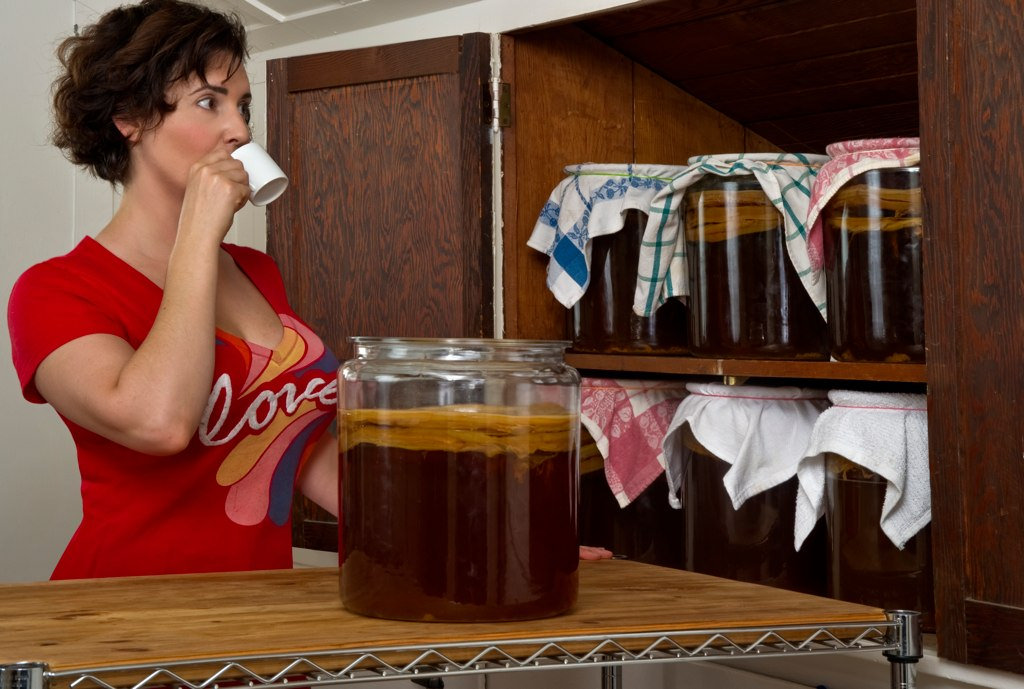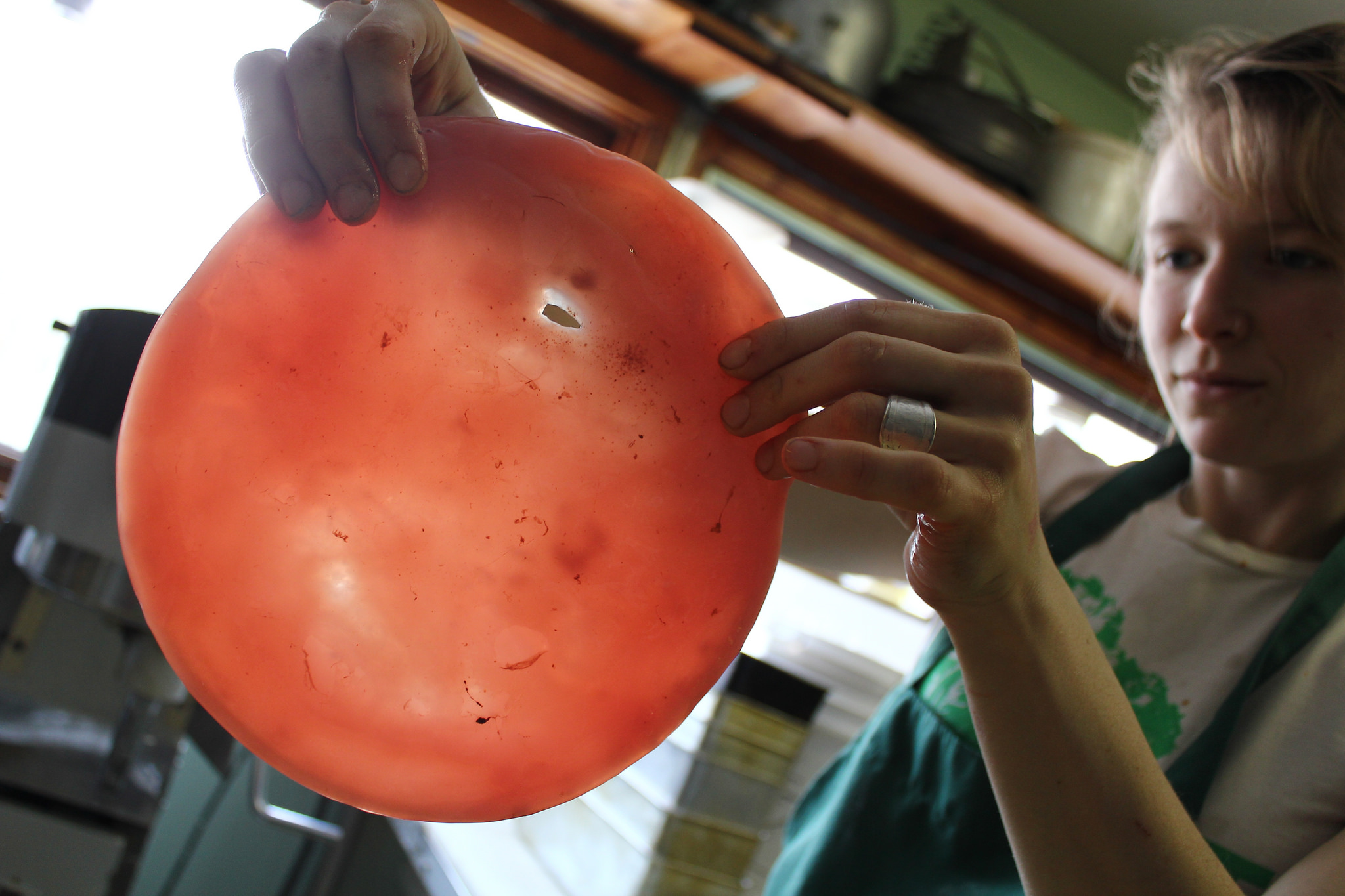Kombucha is a fermented tea that people enjoy for the taste, but also for probiotic benefits that can support healthier digestion. It’s so popular that many kombucha lovers go the homebrew route to customise their own. The problem, though, is that when brewed incorrectly it can be a serious food safety risk.
Kombucha, also called mushroom tea, is a fizzy drink made with brewed black tea, sugar, and a mixed colony of live bacteria and yeast, called SCOBY (Symbiotic Culture Of Bacteria and Yeast). The SCOBY itself is a wide variety of different bacteria and yeasts — some of which we can identify, some we cannot — and can be bought or, if you have kombucha-making pals, gifted.
Recipes vary, but the homemade brewing process remains essentially the same: the sugary concoction of tea and SCOBY sits and ferments for days, sometimes weeks, in the perfect environment for any microorganisms to thrive. It’s the multiple factors around this fermentation step, such as length of fermentation, equipment used, and so on, where things get dicey and has experts advising against making kombucha at home.
The Risks of Getting Ill Exist, But Are Slightly Exaggerated

Quick microbiology 101: Friend or foe, many microorganisms grow rapidly with moisture, nutrients (sugar, fats, and protein), temperatures between four and 60 degrees Celsius, and pH levels between 4.5 and 10. Unfortunately, your fermenting kombucha ticks all of those, so it’s easier to contaminate than you think. The catch-22 here is, the same environment that pathogens love is necessary for the friendly bacteria and yeast to work their magic to produce kombucha. And there’s an upside: as your kombucha properly ferments, it becomes more acidic and creates an inhospitable environment for many of the bad guys.
That said, there have been reports of serious harm associated with kombucha. The most cited report by the US Centres for Disease Control and Prevention (CDC) in 1995 linked kombucha consumption to two illnesses in Iowa. Of the two people who fell ill, one of them died, but a subsequent investigation by the CDC and US Food and Drug Administration did not find conclusive evidence that kombucha was the root cause. In fact, there was no indication of contamination.
However, the CDC did find that the surviving person had fermented their kombucha far longer than the typical week, for 30 days, which made it much more acidic than normal. It turned out the two people were also predisposed to a condition that made it difficult for their body to adjust its own pH. Based on these findings, the CDC determined that drinking 110g of kombucha a day would be fine for otherwise healthy people and recommended against over-fermenting (7-10 days seems to be the normal cut-off) if you brew your own at home, just to be safe. Since that 1995 report, several case studies involving regular kombucha consumption have also been linked to lead poisoning, liver damage, cutaneous anthrax, and metabolic acidosis.
Yes, there’s a small but real danger with preparing your own kombucha, but it’s just like preparing and handling raw meat or making canned goods, where unsanitary conditions and carelessness have a greater chance of contaminating your food stuff with harmful pathogens. Just don’t be negligent.
How to Safely Brew Kombucha at Home

All food safety begins with sanitary conditions. Many problems can nipped in the bud by using sterile equipment, a clean area, and a healthy SCOBY that you’ve gotten from a trusted commercial source. If you’d rather use a friend’s donated SCOBY, make sure your friend knows what he or she is doing. Double check their work by making sure the SCOBY has no black spots and doesn’t otherwise show signs of mould or contamination.
Since you don’t want to kill the kombucha-making friendlies, avoid using bleach and any antibacterial soap. Instead, you can clean and submerge all of your equipment and vessels in water that is over 160 degrees for 30 seconds or more. Oh, and make sure to wash your hands, too. Obviously. In addition to follow the directions, keep these things in mind:
- Brew Your Tea in Very Hot Water: Use hot water that’s over 75 degrees to steep the tea.
- Use Glass Containers: Avoid preparing or storing kombucha in ceramic or lead-containing vessels, since the acidity of the kombucha tea could leach toxic chemicals into the tea itself.
- Don’t Skimp on the Sugar: White sugar is food for the bacteria in your SCOBY, but sufficient amounts also help drop the pH level to minimise the chance of other bacterial growth during the fermentation process. Some people report excellent results from honey, agave, maple syrup, and other alternate sweeteners, but sweeteners like molasses may not produce enough acetic acid-producing bacteria and give you less-than-desirable results.
- Be Careful About Fermenting It Too Long: The typical fermentation period is between 7-10 days, but some people go up to 30 days. The longer it ferments, the more acidic and less sweet it becomes, which can be problematic for people who are sensitive to super acidic foods. The other thing is, typically, alcohol content is below 1%, but it can go as high as 3% after a really long ferment.
When making kombucha, the greatest chance of contamination is during fermentation. To minimise your chance of contamination, you can take a few precautions: Keep the kombucha out of direct sunlight in an open, warm location with good airflow, like the top of your fridge or on your kitchen countertop, away from other objects like plants to avoid cross-contamination. Then make sure your kombucha falls below pH 4.2 after seven days by using pH testing strips.
Otherwise, the culture is likely contaminated or the kombucha is not fermenting enough in a warm enough environment. In either case, if your kombucha doesn’t look or test right, ditch the current batch and start a new one. Don’t try to save the one you have.
At first, you might mistake signs like brown stringy bits, white spots on the liquid’s surface, and the formation of a “baby SCOBY” as contaminated kombucha, but those are actually normal. Keep an eye on your SCOBY and inspect it periodically for mould or other wild bacteria growth. The mould that can ruin a batch of kombucha is the same that can ruin a good loaf of bread, and it usually looks like green or black floaty bits on the kombucha’s surface. Here’s an example of what moldy kombucha looks like. If you’re at all sceptical, throw it out and start over. It’s not worth the risk.
Test your kombucha by using pH testing strips, which should read between 2.6 to 4.2 pH. The alternate and risky way is to actually taste your kombucha by using a straw to draw some liquid. Your kombucha should not smell cheesy or like it’s rotting. It should have a vinegary flavour and aroma.
There’s little evidence to support the wild health claims kombucha fans tout over their favourite drink, but even if you don’t believe them, the drink is tasty and easy to make at home. If you are going to make it, do it with care because homemade kombucha can go wrong if you’re not careful. At best, it will taste like socks after the gym. At worst, you could become seriously ill.

Comments
One response to “How To Safely Brew Your Own Kombucha”
“Supports” means “We can claim no benefit we’d defend in court.”
A temperature of 160° is hard for most people to achieve, water boils at 100° and an average stove top can’t push it much hotter.
It seems non-nonsensical to use mere luke warm water to brew? One would think you would want at least 100° boiling water to brew so that the tannins and flavoids are extracted, then let it cool to 21° and add to the mushroom. 70° tepid water would not even go dark.